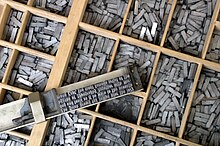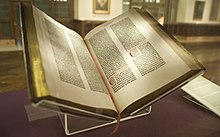Printing press
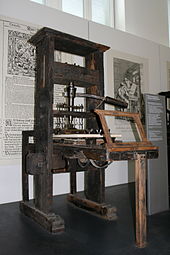


A printing press is a mechanical press with which an image, usually a text, is transferred to a substrate using a colored printing forme , creating an impression . The invention and spread of the printing press , which is widely regarded as the most important event of the second millennium AD, revolutionized the communication and information sector and, as a transmitter and multiplier of knowledge and ideas, significantly ushered in the world epoch of early modernity .
This, associated with the high pressure and letterpress called printing process was in 1440 in the Holy Roman Empire of the German Johannes Gutenberg developed; Gutenberg modified existing techniques such as the screw press and brought them together with his own groundbreaking inventions to form a closed printing system. With the help of his specially created hand casting instrument , movable type could be produced quickly and precisely in large quantities for the first time , a prerequisite for the profitability of the entire letterpress printing.
The mechanization of printing using the printing press led to the first mass production of books in history. A single Renaissance printing press could print 3,600 pages in one working day, compared to forty by hand and a few by copying ; Works by spiritual or secular authorities such as Luther or Erasmus were sold hundreds of thousands of times during their lifetime.
Starting from a single location, Mainz in Germany , knowledge of the printing press spread to over two hundred cities in a dozen European countries within just a few decades. By 1500 the printing presses distributed all over Western Europe had already produced over 20 million printing units. With the further spread of the new printing technology, total production increased tenfold to an estimated 150 to 200 million copies in the course of the 16th century. The maintenance of a print shop went hand in hand with the operation of a printing press that the name of the device was carried over to the new media branch of the press . As early as 1620, the English statesman and philosopher Francis Bacon wrote that printing had given things a new face all over the world.
Since its inception, printing has also been seen and practiced as an art form that has high aesthetic and artistic standards, such as in the famous Gutenberg Bible . Today incunabula are some of the best-kept treasures in large libraries.
The unprecedented influence of the printing press in the wake of Gutenberg's on the long-term development of the history of Europe and the world is difficult to grasp in its entirety. Analytical approaches include the idea of a true printing revolution and the emergence of a Gutenberg galaxy . The wide availability of the printed word at affordable prices encouraged the education of the masses and laid the foundation for the emergence of the modern knowledge society .
In Renaissance Europe , printing with movable type heralded the age of mass communication , which went hand in hand with a profound process of social change: the relatively unhindered access to information and (revolutionary) ideas overcame national borders, captured the masses during the Reformation and threatened the traditional position of power of the political and religious elites; the steep rise in the literacy rate broke the literary upper class' s monopoly on intellectual education and gave the rising middle class a greater say . Printing was not limited to books, any information could be disseminated on printed paper. Across the continent, the growing cultural self-confidence of the peoples led to the development of a proto- nationalism , which was given additional impetus by the gradual displacement of Latin as the lingua franca in favor of the vernacular .
Numerous detail improvements on printing presses were invented and implemented. In the 19th century, the transition to industrial mass production took place with the introduction of steam-driven and later electrically driven printing machines, as well as the invention of the high-speed cylinder press and rotary machines . Printing presses and machines spread around the world and western letterpress technology became the basis for mass printing of our time.
history
Economic conditions and intellectual climate
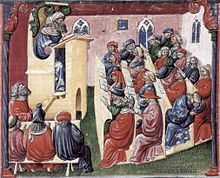
The rapid economic and socio-cultural development at the end of the Middle Ages offered favorable conditions for Gutenberg's invention: The entrepreneurial spirit of early capitalism promoted economic thinking in business life and promoted the rationalization of traditionally handcrafted production methods. The demand for books rose to such an extent that the traditional, time-consuming method of copying by hand could no longer meet the demand due to the growing need for education and the increasing spread of the ability to read in the circles of the middle class . In this situation, the decentralized state of the late medieval world opened up a certain amount of leeway in order to be able to advance individual solutions without the intervention of political and religious authorities.
Technical factors
At the same time, a number of medieval products and technical processes had advanced so far that their use for printing purposes became potentially interesting. Gutenberg's merit is to have recognized these widely dispersed products and processes in their value for book printing, to have brought them together to form a complete and functioning printing system and to have perfected them through a number of our own fundamental inventions and innovations:
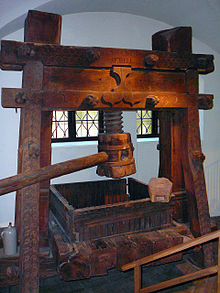
The screw press enables direct pressure to be exerted on a flat surface. Introduced by the Romans in the 1st century AD, it was able to look back on a long history of diversification as early as Gutenberg's time: it was used as a wine press in Mediterranean and medieval agriculture for extracting juice from grapevines and extracting oil from olive pits and other oil seeds. Screw presses were also used as cloth presses in the urban textile industry very early on . Gutenberg could also have been inspired by the paper presses, which since the late 14th century in the German lands were spread and worked on the same mechanical principle.
By adopting the basic design for his printing press, Gutenberg was able to mechanize the printing process, a crucial prerequisite for the mass production of printing units. However, printing made different demands on the machine than pressing. Gutenberg adapted the construction in such a way that the crucible exerted a pressure on the paper that was even and resilient at the same time. To speed up the whole process, he introduced a flat and movable sub-table on which the sheets could be changed quickly.
The idea of movable type was not entirely new in the 15th century; Since the 12th century at the latest, references to knowledge of the typographical principle have appeared sporadically in Europe . Medieval examples of typographic text production, i.e. the continuous reuse of letters to create an entire text, range from Germany ( prüfungingen consecrated inscription ) to Italy ( pilgrim II altarpiece ) to England ( letter tiles ). The practical suitability of the various techniques (stamps, punches and the stringing together of individual letters) was, however, too poor to be able to gain wide acceptance.
Gutenberg succeeded in significantly improving the printing process by establishing setting and printing as two separate work steps. A goldsmith by trade, he cast his letter metal from a lead alloy that proved so suitable for high pressure printing that it is still used today. The mass production of metal letters was made possible by his key invention of a special hand casting instrument , which was ideally suited for the rapid reproduction of identical types . The use of the Latin alphabet was an enormous advantage, as the typesetter could reproduce any text with only about two dozen letters and various punctuation marks.
Another important factor that had a positive effect on the development and spread of printing was the codex format in which books were published since Roman times. In a centuries-long process that is considered to be the most significant development in the history of the book before the invention of printing itself, the Codex had completely supplanted the ancient scroll at the beginning of the Middle Ages (around 500 AD). The codex has considerable practical advantages over the scroll: it is more convenient to read (by turning the pages), more compact, cheaper and above all, in contrast to the scroll , it can be used for writing and printing on the recto and verso .
A fourth development was the rapid mechanization of medieval paper production . The introduction of water-powered paper mills , which have been reliably documented from 1282 onwards, enabled European papermakers to expand their production considerably and displaced the arduous manual work that was common in China and the Muslim world. The number of paper-making centers rose sharply in Italy in the late thirteenth century, where the price of paper fell to one-sixth that of parchment and fell even further; About a hundred years later, the first paper mills started operating in Germany.
Nonetheless, the final breakthrough of paper as a medium for writing seems to have been no less dependent on the rapid spread of letterpress printing with movable type. In this context, it is revealing that parchment codes, the quality of which is considered unsurpassed as writing material, still made up a substantial part of Gutenberg's edition of the 42-line Bible . It was only after numerous attempts that the man from Mainz succeeded in overcoming the difficulties which conventional water-based inks caused by wetting the paper, and in finding a composition for an oil-based printing ink that was suitable for high-quality prints with metal type.
Gutenberg press
Book printing revolution
The book printing revolution ( Elizabeth Eisenstein : "Printing Revolution") as a key historical event can be captured in its quantitative dimension by focusing on the mass production of books and the spread of Gutenberg's printing technology. The printing press can also be examined in terms of its importance as a multiplier of information and ideas, and how its use thus contributed to the change in European and world society.
Mass production and distribution of the printed book


The invention of mechanical letterpress printing with movable type led to a veritable explosion of European letterpress activities in just a few decades. Starting with a single print shop in Mainz (Germany), the art of printing expanded to no fewer than 271 cities in all of Central and Western Europe by the end of the 15th century. As early as 1480, printers had started operations in 110 locations in Germany, Italy, France, Spain, the Netherlands, Belgium, Switzerland, England, Bohemia and Poland; From that time on, the printed book is believed to be in common use in Europe.
In Italy, an early center of 'black art', printing works were opened in 77 cities by 1,500. By the end of the following century, a total of nearly three thousand printers had been active in 151 different parts of the country. Despite the wide distribution, production centers soon began to emerge; this is how a third of the Italian printers worked from Venice .

By 1500, printing presses had produced more than twenty million printing units across Western Europe. In the following century, the total print run increased tenfold to an estimated 150 to 200 million copies.
European printing presses around the year 1600 had a printing capacity of around 3,600 pages per working day. For comparison: in the Far East, where presses were unknown and only manual printer prints were made, daily production did not exceed forty.
The huge printing capacity available meant that individual authors could now become real bestsellers : at least 750,000 of Erasmus' works (1469–1536) were sold during his lifetime alone. At the beginning of the Reformation princes and were Pope surprised by the revolutionary potential of the mass printing alike: Alone in the short period of 1518-1524, the book production climbed in Germany seven times into the air; Between 1518 and 1520, 300,000 printed copies of Luther's treatises circulated in the country .
The enormous time savings through the typographical text production as well as the drastic reduction of the production costs prepared the field for the publication of the first newspapers (see relation ), which offered the public a completely new source of information.
A permanent legacy of the time are the incunabula , preserved printed works from the 15th century, which belong to the protected core inventory of many respected libraries in Europe and North America.
Dissemination of information and ideas
Stanhope press
The British politician and inventor Charles Stanhope built the first iron printing press around 1800.
Print capacity
The table shows the maximum printing performance of various printing presses per hour.
| Hand operated presses | Steam powered machines | |||||
|---|---|---|---|---|---|---|
|
Gutenberg press around 1600 |
Stanhope press around 1800 |
Koenig & Bauer 1812 |
Koenig & Bauer 1813 |
Koenig & Bauer 1814 |
Koenig & Bauer 1818 |
|
| Pages per hour | 240 | 480 | 800 | 1,100 | 2,000 | 2,400 |
See also
literature
- Significance for communication history
- Elizabeth L. Eisenstein: The Printing Press as an Agent of Change . Cambridge University Press, 1980, ISBN 0-521-29955-1
- Elizabeth L. Eisenstein: The Printing Revolution in Early Modern Europe . 2nd, change Edition. Cambridge University Press, 2005, ISBN 0-521-60774-4
- Lucien Febvre , Henri-Jean Martin: The Coming of the Book: The Impact of Printing 1450-1800 . Verso, London 1997, ISBN 1-85984-108-2
- John Man: The Gutenberg Revolution: The Story of a Genius and an Invention that Changed the World . Headline Review, London 2002, ISBN 978-0-7472-4504-9
- Marshall McLuhan : The Gutenberg Galaxy: The Making of Typographic Man . 1st edition. University of Toronto Press, 1962, ISBN 978-0-8020-6041-9
- Printing technology
- Hans Bolza: Friedrich Koenig and the invention of the printing press . In: History of Technology . Vol. 34, No. 1, 1967, pp. 79-89
- Gedeon Borsa: Printing places in Italy before 1601 . In: Gutenberg-Jahrbuch 1976. pp. 311-314
- Gedeon Borsa: printer in Italy before 1601 . In: Gutenberg-Jahrbuch 1977. pp. 166-169
- Herbert E. Brekle : Another trace of a typographical workshop in the 12th century at the convent in Prüfing (PDF; 8.0 MB). In: Gutenberg-Jahrbuch 1995. Vol. 70, pp. 23-26
- Herbert E. Brekle: The typographical principle. Attempt to clarify the terms . In: Gutenberg-Jahrbuch 1997. Vol. 72, pp. 58–63 ( PDF )
- Herbert E. Brekle: Theprüfungingen dedication inscription from 1119. A palaeographical-typographical investigation . [short summary] Scriptorium Verlag für Kultur und Wissenschaft, Regensburg 2005, ISBN 3-937527-06-0
- Herbert E. Brekle: The typographical production technique of the inscriptions on the silver altarpiece in the cathedral of Cividale , Regensburg 2011
- Eltjo Buringh, Jan Luiten van Zanden: Charting the Rise of the West: Manuscripts and Printed Books in Europe, A Long-Term Perspective from the Sixth through Eighteenth Centuries . In: The Journal of Economic History , Vol. 69, No. 2, 2009, pp. 409-445
- Robert I. Burns: Paper Comes to the West, 800-1400 . In: Uta Lindgren (Ed.): European technology in the Middle Ages. 800 to 1400. Tradition and innovation . 4th edition. Gebr. Mann Verlag, Berlin 1996, ISBN 3-7861-1748-9 , pp. 413-422
- Diana Childress: Johannes Gutenberg and the Printing Press . Twenty-First Century Books, Minneapolis 2008, ISBN 978-0-7613-4024-9
- K. Dieterichs: The book printing press from Johannes Gutenberg to Friedrich König. Mainz 1930.
- Hye-bong Ch'on: Typography in Korea . In: Korean Foundation (ed.): Koreana . tape 7 No. 2. Seoul 1993, p. 10-19 .
- Claus W. Gerhardt : Why was the Gutenberg press only replaced by a better system after more than 350 years? In: Gutenberg-Jahrbuch 1971, pp. 43–57
- Claus W. Gerhardt: Does Gutenberg's invention still have any value today? In: Gutenberg-Jahrbuch 1978, pp. 212–217
- Lotte Hellinga : The Gutenberg Revolutions . In: Simon Eliot, Jonathan Rose (Eds.): A Companion to the History of the Book . Blackwell Publishing, 2007, ISBN 978-1-4051-2765-3 , pp. 207-220
- Charles Issawi: Europe, the Middle East and the Shift in Power: Reflections on a Theme by Marshall Hodgson . In: Comparative Studies in Society and History , Vol. 22, No. 4, 1980, pp. 487-504
- Walter Koch : Literature report on medieval and modern epigraphy (1985–1991) . In: Monumenta Germaniae Historica : Aids , Vol. 14, Munich 1994, ISBN 978-3-88612-114-4 , p. 213
- Hellmut Lehmann-Haupt: English wooden stamp alphabets of the XIII. Century . In: Gutenberg-Jahrbuch 1940, pp. 93–97
- Angelo Lipinsky: La pala argentea del Patriarca Pellegrino nella Collegiata di Cividale e le sue iscrizioni con caratteri mobili . In: Ateneo Veneto 1986, Vol. 24, pp. 75-80
- Adam Robert Lucas: Industrial Milling in the Ancient and Medieval Worlds. A Survey of the Evidence for an Industrial Revolution in Medieval Europe . In: Technology and Culture , Vol. 46, No. 1, 2005, pp. 1-30
- Joseph Needham: Science and Civilization in China , Physics and Physical Technology (Vol. 4), Mechanical Engineering (Part 2), Cambridge University Press, 1965
- Björn Onken: Pressing . In: Hubert Cancik, Helmuth Schneider (Ed.): Der Neue Pauly , 2009
- Printing . In: Encyclopædia Britannica 2006, accessed November 27, 2006
- Colin H. Roberts, TC Skeat: The Birth of the Codex . Oxford University Press, London 1983, ISBN 0-19-726024-1
- Helmuth Schneider: Technology . In: Walter Scheidel (Ed.): The Cambridge Economic History of the Greco-Roman World , Cambridge University Press, 2007, ISBN 978-0-521-78053-7 , pp. 144-171
- Alfred Schulte: paper press, printing press and wine press . In: Gutenberg-Jahrbuch 1939, pp. 52–56
- Susan Thompson: Paper Manufacturing and Early Books . In: Annals of the New York Academy of Sciences , Vol. 314, 1978, pp. 167-176
- Tsuen-Hsuin Tsien: Science and Civilization in China . Chemistry and Chemical Technology (Vol. 5), Paper and Printing (Part 1), Cambridge University Press, 1985
- Johannes Weber: Strasbourg 1605. The birth of the newspaper . In: Yearbook for Communication History . Vol. 7, 2005, pp. 3-26
- KD White: Greek and Roman Technology . Thames and Hudson, London 1984
- Hans Widmann: The Korean printing press and Gutenberg's invention . In: Gutenberg-Jahrbuch 1974, pp. 32–34
- Hans-Jürgen Wolf: History of Printing Presses , Interprint, Frankfurt / Main 1974
Web links
- The Printing Press , at: Internet Shakespeare Editions ; accessed on October 6, 2015
References and comments
- ↑ See People of the Millennium ( Memento of the original from March 3, 2012 in the Internet Archive ) Info: The archive link was automatically inserted and not yet checked. Please check the original and archive link according to the instructions and then remove this notice. for an overview of the numerous honors at the turn of the millennium. In 1999 the A&E Network voted Gutenberg first in their “People of the Millennium” countdown . In 1997, Time-Life magazine praised Gutenberg's invention as the most important of the 2nd millennium ( memento of the original from March 10, 2010 in the Internet Archive ) Info: The archive link was automatically inserted and not yet checked. Please check the original and archive link according to the instructions and then remove this notice. ; Four well-known US journalists did the same in 1998 in their review 1,000 Years, 1,000 People: Ranking The Men and Women Who Shaped The Millennium ( Memento of the original from March 3, 2012 in the Internet Archive ) Info: The archive link was automatically inserted and not yet checked . Please check the original and archive link according to the instructions and then remove this notice. . In the entry Johann Gutenberg of the Catholic Encyclopedia , the Mainzer's invention is attributed an unprecedented cultural influence in the Christian era .
- ↑ McLuhan 1962; Eisenstein 1980; Febvre, Martin 1997; Man 2002
-
↑ McLuhan 1962, p. 124:
"The invention of typography confirmed and extended the new visual stress of applied knowledge, providing the first uniformly repeatable commodity, the first assembly-line, and the first mass production."
- ↑ a b Wolf 1974, p. 67f.
- ↑ a b Ch'on Hye-bong 1993, p. 12
- ↑ Issawi 1980, p. 492
- ↑ a b c d e f g Febvre, Lucien; Martin, Henri-Jean (1976): The Coming of the Book: The Impact of Printing 1450-1800 , New Left Books, London, quoted in: Anderson, Benedict (1993): Comunidades Imaginadas. Reflexiones sobre el origen y la difusión del nacionalismo , Fondo de cultura económica, Mexico City, ISBN 978-968-16-3867-2 , pp. 58f.
- ^ Weber 2005, p. 3
- ^ Francis Bacon : Novum Organum, Liber I, CXXIX on Wikisource
- ↑ Anderson, Benedict: Comunidades Imaginadas. Reflexiones sobre el origen y la difusión del nacionalismo , Fondo de cultura económica, Mexico 1993, ISBN 978-968-16-3867-2 , pp. 63-76
- ↑ Eisenstein 1980; Febvre, Martin 1997; Man 2002
- ↑ Wolf 1974, pp. 21-35
- ↑ Onken 2009; White 1984, pp. 31f .; Schneider 2007, pp. 156-159
- ↑ Schneider 2007, p. 158
- ↑ Schulte 1939, p. 56
- ↑ Wolf 1974, p. 39f.
- ↑ Wolf 1974, pp. 39-46
- ↑ Germany: Brekle 1995, pp. 23-26; Brekle 1997, p. 62; Brekle 2005, p. 25; Italy: Lipinsky 1986, pp. 75-80; Koch 1994, p. 213; Brekle 2011, p. 19; England: Lehmann-Haupt 1940, pp. 93-97; Brekle 1997, p. 62. Lipinsky suspects that this typographical technique was known in Constantinople from the 10th to the 12th century and that the Venetians adopted it from there (p. 78).
- ^ Encyclopædia Britannica 2006: "Printing", accessed November 27, 2006
- ↑ Childress 2008, pp. 51-55
- ↑ Childress 2008, pp. 51-55; Hellinga 2007, p. 208
- ↑ Roberts, Skeat 1983, pp. 24-30
- ↑ Roberts, Skeat 1983, pp. 1, 38-67, 75
- ↑ Roberts, Skeat 1983, pp. 45-53. Technically speaking, there is nothing to prevent the back of a scroll from being inscribed, but the very small number of such ancient specimens indicates that this was never seen as a real alternative (p. 46).
- ↑ Burns 1996, p. 418
- ↑ Thompson 1978, p. 169; Tsien, Tsuen-Hsuin 1985, pp. 68-73; Lucas 2005, p. 28, footnote 70
- ↑ Thompson 1978, p. 169; Burns 1996, pp. 414-417
- ↑ Burns 1996, p. 417
- ↑ Febvre, Martin 1997, pp. 41-44; Burns 1996, p. 419
- ↑ Roberts, Skeat 1983, pp. 7f.
- ↑ The ratio of paper to parchment copies is estimated to be around 150 to 30 (Hanebutt-Benz 2000, pp. 158–189).
- ↑ Childress 2008, p. 60
- ^ A b Incunabula Short Title Catalog . British Library . Retrieved March 2, 2011.
- ↑ Buringh, van Zanden 2009, p. 416f., Panels 1 & 2. An estimated 5 million manuscripts were produced in the 15th century.
- ↑ Borsa 1976, p. 314; Borsa 1977, pp. 166-169
- ↑ Needham 1965, p. 211; Widmann 1974, p. 34, footnote 14; Man 2002, pp. 112-115; Encyclopædia Britannica 2006: "Printing"
- ↑ Issawi 1980, p. 492
- ↑ Weber 2006, p. 387f.
- ↑ The British Library Incunabula Short Title Catalog lists 29,777 editions on January 8, 2008, including some printed works from the 16th century (as of March 11, 2010). According to Bettina Wagner : “The second life of the cradle prints. The Incunabula Collection of the Bayerische Staatsbibliothek ”, in: Griebel, Rolf; Ceynowa, Klaus (Ed.): Information, Innovation, Inspiration. 450 Years of the Bavarian State Library , KG Saur, Munich 2008, ISBN 978-3-598-11772-5 , pp. 207-224 (207f.) Is the number of issues in the Incunabula Short Title Catalog that appeared before 1501 are, on 28,107.
- ↑ Wolf 1974, p. 67f.
- ↑ Bolza 1967, p. 80
- ↑ Bolza 1967, p. 83
- ↑ Bolza 1967, p. 87
- ↑ a b Bolza 1967, p. 88
